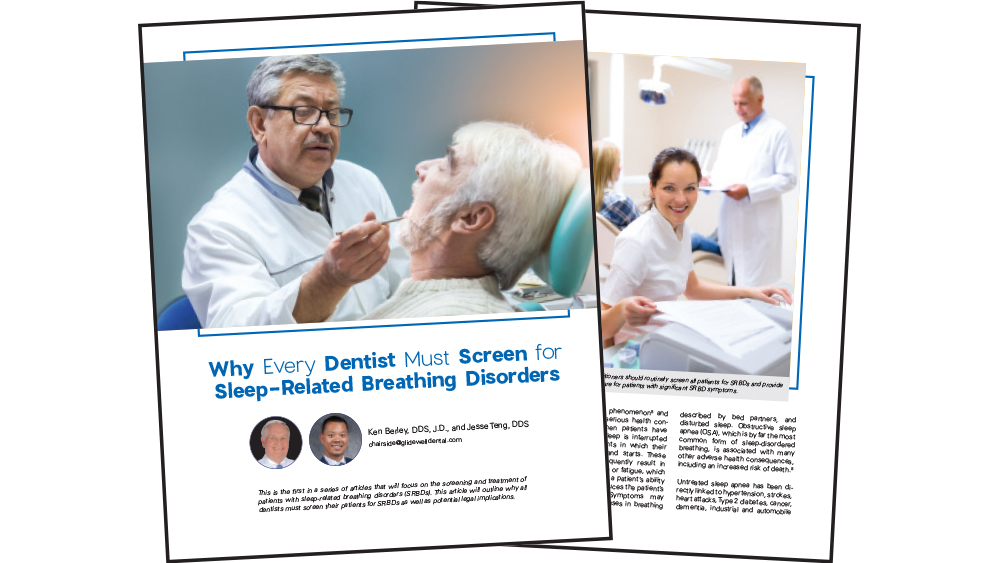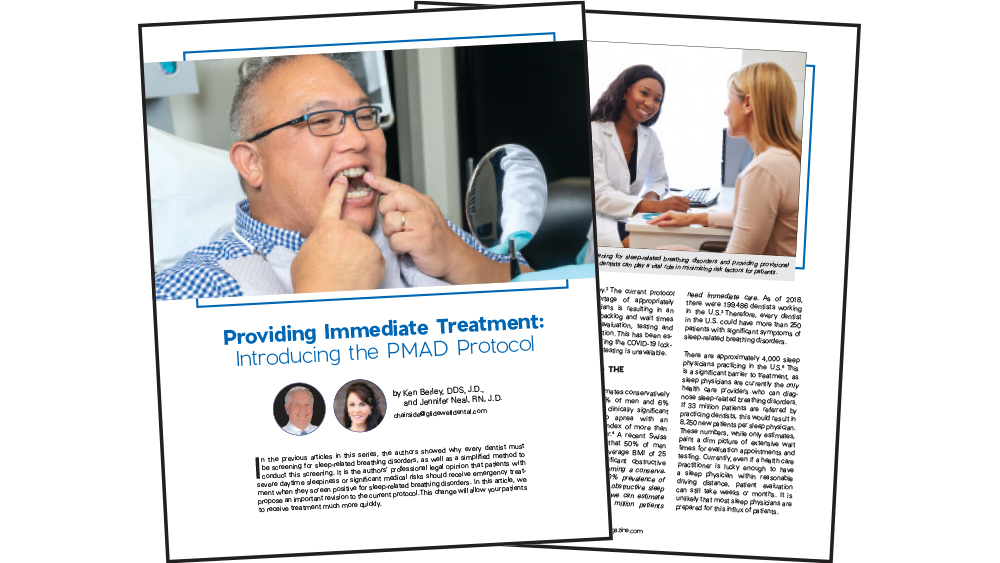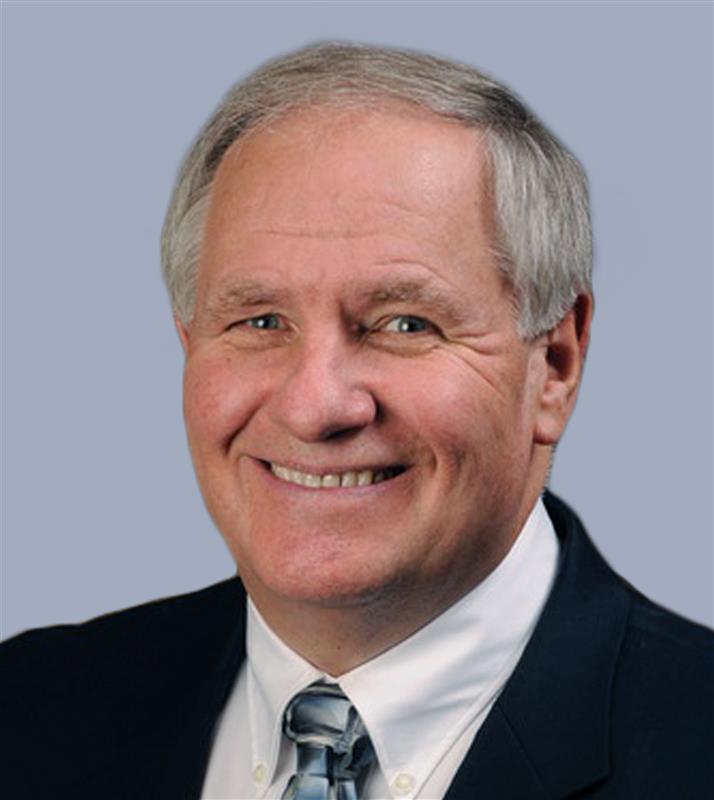Providing Immediate Treatment: Introducing the PMAD Protocol

In the previous articles in this series, the authors showed why every dentist must be screening for sleep-related breathing disorders, as well as a simplified method to conduct this screening. It is the authors’ professional legal opinion that patients with severe daytime sleepiness or significant medical risks should receive emergency treatment when they screen positive for sleep-related breathing disorders. The following article proposes an important revision to the current protocol. This change will allow your patients to receive treatment much more quickly.
During the COVID-19 pandemic, we have learned that the need for immediate treatment of suspected obstructive sleep apnea has become even more pressing. Sleep apnea, along with other chronic respiratory conditions, is a known risk factor for COVID-19. The virus rapidly attacks alveoli in the lungs that perform the life-sustaining gas exchange of oxygen and CO2. This damage leads to severe pneumonia and, in many cases, death.
Complicating the situation even further, as a direct result of the pandemic, most sleep labs have shut down and polysomnograms are not being performed. The wait time for treatment is unacceptably long. Dental sleep medicine providers can play a vital role in minimizing risk factors for patients with untreated obstructive sleep apnea by fitting these patients with a provisional oral appliance until they are able to visit a sleep physician. Early treatment is crucial in normal circumstances, but now it is vital to save lives.

By screening for sleep-related breathing disorders and providing provisional therapy, dentists can play a vital role in minimizing risk factors for patients.
PROTOCOL FOR DENTAL SLEEP MEDICINE
The current protocol for treatment of sleep-related breathing disorders requires that all dentists screen their patients for symptoms and then refer positive-screened patients to a sleep physician or other knowledgeable physician for definitive diagnosis and plan of care.1 The American Academy of Sleep Medicine (AASM) has determined that dentists are inadequately trained and, therefore, unqualified to determine the necessity of screenings or the best treatment for their patients with airway issues. The current protocol requires that all positive-screened patients be examined by a knowledgeable physician to evaluate whether a sleep test is indicated. If an overnight sleep test is performed and the patient is diagnosed with obstructive sleep apnea, the supervising physician will initiate therapy.2 The current protocol and the shortage of appropriately trained physicians is resulting in an unacceptable backlog and wait times for physician evaluation, testing and treatment initiation. This has been especially true during the COVID-19 lockdown, as sleep testing is unavailable.
HOW BIG IS THE PROBLEM?
Most recent estimates conservatively suggest that 13% of men and 6% of women have clinically significant obstructive sleep apnea with an apnea-hypopnea index of more than 15 events an hour.4 A recent Swiss study also found that 50% of men over 40 with an average BMI of 25 had clinically significant obstructive sleep apnea.5 Assuming a conservative estimate of 10% prevalence of clinically significant obstructive sleep apnea in the U.S., we can estimate that more than 33 million patients need immediate care. As of 2018, there were 199,486 dentists working in the U.S.3 Therefore, every dentist in the U.S. could have more than 250 patients with significant symptoms of sleep-related breathing disorders.
There are approximately 4,000 sleep physicians practicing in the U.S.6 This is a significant barrier to treatment, asleep physicians are currently the only health care providers who can diagnose sleep-related breathing disorders. If 33 million patients are referred by practicing dentists, this would result in 8,250 new patients per sleep physician. These numbers, while only estimates, paint a dim picture of extensive wait times for evaluation appointments and testing. Currently, even if a health care practitioner is lucky enough to have a sleep physician within reasonable driving distance, patient evaluation can still take weeks or months. It is unlikely that most sleep physicians are prepared for this influx of patients.
From a medical-legal perspective, once a patient has been screened and identified, time is of the essence. Obstructive sleep apnea is a highly prevalent condition with major health consequences.2 It is a risk factor not only to patients with the condition, but also to the millions of innocent bystanders who happen to share the road with patients who have undiagnosed or uncontrolled obstructive sleep apnea.7 Additionally, the treatment of sleep-related breathing disorders has been shown to improve the clinical outcomes of patients who suffer from atrial fibrillation8 and hypertension,9 and studies have even found that treatment reduces overall mortality rates in men10 and women.11

Provisional therapy for sleep-related breathing disorders can be life-saving not just for patients but also for fellow drivers.
SEVERE OBSTRUCTIVE SLEEP APNEA IS AN EMERGENCY
With the adoption of the ADA policy statement on the dentist’s role in the treatment of sleep-related breathing disorders, all dentists should now be screening their patients for obstructive sleep apnea. If you are unsure of how to screen your patients, see our previous article in this issue of Chairside® magazine about screening techniques. The most important question that we now ask is, what are our ethical and legal responsibilities when a dentist discovers that a patient is dangerously sleepy after the obligatory screening? It is the authors’ professional and legal opinion that patients with significant sleep-related breathing disorder symptoms, such as severe refractory high blood pressure, heart disease, stroke or severe daytime sleepiness, should be provided immediate care.
In 1993, the Louisiana State Court found that the risks associated with obstructive sleep apnea are life-threatening and therefore constitute a medical emergency that requires immediate therapy. The current treatment protocol does not provide for timely therapy without a sleep physician providing a diagnosis and directing emergency therapy. For the safety of patients and society, this protocol should be modified to allow for provisional therapy when severe symptoms are present.
EMERGENCY TREATMENT FOR SEVERE OBSTRUCTIVE SLEEP APNEA
Upon determining that a patient is severely sleepy or is at risk for serious medical consequences, proactive therapy should be initiated. The Epworth Sleepiness Scale (ESS), which was discussed in our previous Chairside article, is a screening tool used to determine if a patient is dangerously sleepy. The ESS features a series of questions to determine the likelihood of a patient falling asleep in various situations. Patients who score 10 or higher on the ESS should be considered unacceptably sleepy and, therefore, present a legal risk for the screening dentist.

Patients who are dangerously sleepy and have a recent history of stroke or heart attack need immediate help. They should be treated as emergency cases.
PROVISIONAL MANDIBULAR ADVANCEMENT DEVICES
Patients who are excessively sleepy or are medically compromised should be fitted with a provisional appliance to minimize symptoms. A provisional mandibular advancement device is indicated for patients who present with an ESS of 10 or greater, significant difficulty sleeping, severe refractory hypertension, a recent history of stroke or heart attack, or a history of falling asleep at unexpected times. These patients need immediate help and should be treated as emergency cases.
After a qualified dentist evaluates a patient for sleep-related breathing disorder symptoms, the patient must be informed of the assessment results and a plan should be discussed. The assessments made by a dentist when examining a patient may result in a provisional or working diagnosis of severe obstructive sleep apnea. A provisional diagnosis is made by a professional based on currently available information. These diagnoses are based on subjective and objective signs and symptoms, and confirmation frequently requires additional testing and consultation with colleagues. Appropriate testing is then ordered to provide the information required for a definitive diagnosis. The provisional diagnosis will exist until it is replaced. Ideally, a provisional diagnosis becomes an exact diagnosis after completion of initial testing and gathering of more information.12
Without a provisional diagnosis of sleep-related breathing disorders based on subjective symptoms and objective evaluation, referral to a sleep physician would be inappropriate. A trained dental sleep medicine provider should inform the patient of the screening results and the danger associated with obstructive sleep apnea. If the patient’s symptoms raise concern, the discussion should include the fabrication of a provisional mandibular advancement device.
Provisional or initial therapy should be initiated based on a working diagnosis of severe obstructive sleep apnea, depending on the nature of the patient’s symptoms. Seriousness of symptoms frequently drives provisional therapy: The more disruptive and life-threatening the symptoms, the more likely some type of provisional therapy will be initiated based on those symptoms. Treating “symptoms” without a definitive diagnosis is a common protocol in the medical and dental professions.
COVID-19 and CPAP
Historically, continuous positive airway pressure (CPAP) therapy has been considered the gold standard for treating obstructive sleep apnea. Most physicians prescribe CPAP initially, with oral appliance therapy considered only if CPAP is not effective. However, with the spread of COVID-19, the AASM has indicated that CPAP therapy may increase the risk of spreading the virus or causing a reinfection of the patient. CPAP potentially exposes individuals who are in close proximity by generating aerosols, potentially spreading the coronavirus.13 There have been a number of studies demonstrating that the COVID-19 virus can stay suspended in the air once aerosolized.14 Further complicating CPAP therapy are reported shortages of distilled water and various disinfectants needed for cleaning and utilization of CPAP systems. If the COVID-19 virus contaminates a patient’s CPAP equipment, the coronavirus can remain in the CPAP device and the patient is at risk of reinfection from contaminated CPAP tubing, filters or masks.
As a result of the ongoing complications of CPAP usage during this pandemic, oral appliance therapy has become the first-line treatment to safely control obstructive sleep apnea without generating aerosols.
In response to these concerns, the AADSM has issued the following statement:
It is the position of the American Academy of Dental Sleep Medicine (AADSM) that oral appliance therapy (OAT) should be prescribed as a first-line therapy for the treatment of obstructive sleep apnea (OSA) during the COVID-19 pandemic.15
Appliances
Although there are a number of temporary appliances available, we would like to draw a distinction between “temporary appliances” and “provisional appliances.” Temporary appliances have been well studied and have not been very effective. They are not custom-fabricated and are designed to be used for a short period of time (e.g., 30 days). The provisional appliances that we recommend are custom-fabricated appliances, which can be provided quickly and are relatively inexpensive for the patient. Examples of provisional mandibular advancement devices include the Silent Nite® Sleep Appliance and EMA® sleep apnea device (Frantz Design Inc.; Austin, Texas). These appliances are comfortable and can easily function for the period between the dental office screening and the sleep physician evaluation.
Silent Nite and EMA appliances are custom-fabricated from impressions or scans of the patient’s dentition, and can be provided quickly and without great expense. If the patient’s dentition is scanned, the Silent Nite or EMA appliance can be provided after just three in-lab working days.

CONCLUSION
Obstructive sleep apnea is rampant and is a known complicating factor in COVID-19. Any delay in the treatment of patients with severe sleep-related breathing disorders can only result in more suffering. A provisional mandibular advancement device may be custom-fabricated to minimize symptoms and reduce risk until a definitive diagnosis and permanent treatment can be initiated. Dental sleep medicine practitioners are encouraged to discuss this treatment option with local sleep physicians. Adopting this protocol can only improve patient outcomes.
Disclaimer: The information provided in this article is not intended to be taken as legal advice and is not guaranteed to be correct, complete or up-to-date. Laws change rapidly, and the authors cannot guarantee that all of the information in this article is completely current. The law differs from jurisdiction to jurisdiction and is subject to interpretation by different courts. The law is a personal matter, and the general information provided in an article cannot fit every circumstance. Therefore, if you need legal advice for your specific problem, you should consult a licensed attorney in your area.
Related Articles

Click here for Part 1: "Why Every Dentist Must Screen for Sleep-Related Breathing Disorders"

Click here for Part 2: "Screening Patients for Sleep-Related Breathing Disorders"
References
- ^American Dental Association [internet]. Chicago: American Dental Association; c2019. The role of dentistry in the treatment of sleep related breathing disorders [cited 2019 Aug 25]. Available from: www.ada.org/~/media/ADA/Member%20Center/FIles/The-Role-of-Dentistry-in-Sleep-Related-Breathing-Disorders.pdf.
- ^Levine M, Bennett K, et al. Dental sleep medicine standards for screening, treating and managing adults with sleep-related breathing disorders. J Dent Sleep Med. 2018;5(3).
- ^American Dental Association [internet]. Chicago: American Dental Association; c2020. Available from: https://www.ada.org/.
- ^Peppard PE, Young T, Barnet JH, Palta M, Hagen EW, Hla KM. Increased prevalence of sleep-disordered breathing in adults. Am J Epidemiol. 2013 May 1;177(9):1006-14.
- ^Heinzer R, Vat S, Marques-Vidal P, Marti-Soler H, Andries D, Tobback N, Mooser V, Preisig M, Malhotra A, Waeber F, et al. Prevalence of sleep-disordered breathing in the general population: the HypnoLaus study. Lancet Respir Med. 2015 Apr;3(4):310-8.
- ^Phillips B, Gozal D, Malhotra A. What is the future of sleep medicine in the United States? Am J Respir Crit Care Med. 2015 Oct 15;192(8):915-7.
- ^Tregear S, Reston J, Schoelles K, Phillips B. Continuous positive airway pressure reduces risk of motor vehicle crash among drivers with obstructive sleep apnea: systematic review and meta-analysis. Sleep. 2010 Oct;33(10):1373-80.
- ^Holmqvist F, Guan N, Zhu Z, Kowey PR, Allen LA, Fonarow GC, Hylek EM, Mahaffey KW, Freeman JV. Chang P, et al. Impact of obstructive sleep apnea and continuous positive airway pressure therapy on outcomes in patients with atrial fibrillation — results from the Outcomes Registry for Better Informed Treatment of Atrial Fibrillation (OBIT-AF). Am Heart J. 2015 May;169(5):647-654.e2.
- ^Fava C, Dorigoni S, Dalle Vedove F, Danese E, Montagnana M, Guidi GC, Narkiewicz K, Minuz P. Effect of CPAP on blood pressure in patients with OSA/hypopnea: a systematic review and meta-analysis. Chest. 2014 Apr;145(4):762-71.
- ^Marin JM, Carrizo SJ, Vicente E, Agusti AG. Long-term cardiovascular outcomes in men with obstructive sleep apnoea-hypopnoea with or without treatment with continuous positive airway pressure: an observational study. Lancet. 2005 Mar 19-25;365(9464):1046-53.
- ^Campos-Rodriguez F, Martinez-Garcia MA, de la Cruz-Moron I, Almeida Gonzalez C, Catalan-Serra P, Montserrat JM. Cardiovascular mortality in women with obstructive sleep apnea with or without continuous positive airway pressure treatment: a cohort study. Ann Intern Med. 2012 Jan 17;156(2):115-22.
- ^Reference.com [internet]. New York: IAC; c2020. What is a provisional diagnosis? [cited 2020 Jun 4]. Available from: https://www.reference.com/world-view/provisional-diagnosis-e4a215469ba7888d.
- ^American Academy of Sleep Medicine [internet]. Darien (IL): American Academy of Sleep Medicine; c2020. COVID-19: FAQs for sleep clinicians [updated 2020 Apr 7; cited 2020 Jun 4]. Available from: https://aasm.org/covid-19-resources/covid-19-faq.
- ^Liu Y, Ning Z, Chen Y, et al. Aerodynamic analysis of SARS-CoV-2 in two Wuhan hospitals. Nature. 2020 Apr 27. https://doi.org/10.1038/s41586-020-2271-3. Online ahead of print.
- ^Schwartz D, Addy N, Levine M, Smith H. Oral appliance therapy should be prescribed as a first-line therapy for OSA during the COVID-19 pandemic. J Dent Sleep Med.2020;7(3).




